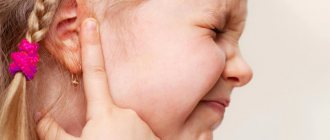If you have a baby, then your child’s fear probably worries you greatly. Young children can be afraid of absolutely any thing, but which one cannot be predicted in advance. It’s good if you managed to protect your baby from fright.
But what if not?
Let's look into this together with experts.
How does a child show fear?
Of course, this cannot be said that fear is categorically bad, because it is an emotion created for the sake of survival. For example, a baby was once frightened by an unexpected car, a dog, or a thunderstorm, but he will forever remember that the object of his fear is something that, in theory, could cause harm, so he will know what needs to be handled carefully. Therefore, if you tell him not to touch the hot kettle, he will still do it - though only once or a couple of times, until he understands that it is not worth doing. But sometimes short-term fear entails fright in the child. It happens that fear passes easily, but other times it can lead to serious consequences - developmental pathologies. And children's vulnerability is connected with the fact that kids are too emotional - sometimes they are overly sensitive to external changes, since excitatory processes in their nervous system prevail over inhibitory ones. Let's first figure out how to identify severe fright so that we know exactly what to do next.
Signs
There are several signs that you can notice in a baby at the moment when he encounters an object of fear:
- Increased heart rate;
- A slight holding of breath followed by crying;
- Involuntary bowel movements or urination;
- Pupil dilation;
- Disorientation;
- Nervous twitching;
- A grimace of panic or even horror.
The problem is that even if you are an extremely attentive parent, you may still miss these signs.
Chronic symptoms
But there are also more serious, chronic symptoms that can even be attributed to a number of consequences of childhood fear.
- Enuresis over the age of four years (this diagnosis must be made by a doctor);
- Stuttering in speech or its absence at all (without the presence of other speech therapy problems);
- A categorical refusal to remain alone, without parents;
- Unreasonable, prolonged crying;
- Social maladjustment, isolation;
- Refusal to sleep without light;
- Refusal to sleep alone in bed;
- Serious changes in eating behavior (decreased appetite, increased cravings for sweets, or others);
- Restless sleep, nightmares, crying at night.
Remember!
Fear and aggression are two human emotions that go shoulder to shoulder, which is due to evolution.
Even the physiological mechanism of their appearance is initially the same, then there is a branching into two defensive reactions: passive and active (respectively, to fear and aggression). Therefore, you can observe how these two phenomena will be combined in your child’s behavior. For example, if a baby is afraid of something, then he may not hide behind his mother, but go into an active defensive reaction: he was scared of the cat and attacked her in order to “win.” Therefore, sometimes fear and fright lead to the development of such a personality trait as aggressiveness.
What can a child be afraid of?
Young children are too emotional and sometimes overreact to any changes occurring in the environment.
This is due to the predominance of excitatory processes in the cerebral cortex over inhibitory ones. Therefore, even a minor external irritant can provoke not only fear in a child, but can also lead him to hysterics, the reasons for which will be recorded in memory for a long time. Parents should clearly know the situations associated with the appearance of fear in the baby. After all, the baby needs to be protected from them. Otherwise, there is a risk of developing not only psychological problems, but also quite obvious pathologies of the nervous system.
Causes of fear in newborns and infants
Many young parents believe that newborns do not experience any emotions and develop only at the level of instincts: “ate, sleep, go to the toilet.” Scientists have long proven that this is a completely wrong point of view. The child begins to explore the world around him while still in the womb. The baby seems to read the woman’s psychological state. It’s not for nothing that everyone is trying to protect pregnant women from unpleasant news and situations.
Therefore, such a phenomenon as fright in an infant cannot be classified as too rare. On the contrary, changing a comfortable environment to an unfamiliar, noisy and bright one causes fear, which can be overcome with attentive attention from mom and dad.
The following can provoke a negative reaction in a baby:
- sharp loud sound, flashing light (thunder, lightning, exclamations in the apartment or on the street, alarms, explosions, etc.);
- a fall;
- staying in a room without parents for a long time;
- abuse by adults;
- bathing.
In principle, any new action or phenomenon during this period can cause fear in a newborn. You should behave very carefully with tiny children so as not to harm their unstable psyche.
Causes of fear in children of preschool and primary school age
As the child grows older, even more factors arise in the environment that can cause fear and fright. Starting from the age of one year, the baby tries with all his might to explore everything that is near him. The formation of basic higher mental functions takes place, and disruption of this process can subsequently affect major problems in the intellectual sphere. At this moment, parents should protect their children from various negative emotions and help them develop in the right direction.
The following can cause fear in a child of preschool and primary school age:
- sudden noise, especially during sleep;
- aggressive behavior of large pets or simply their unsuccessful attempt to play;
- unknown natural phenomena (lightning, strong wind, hail);
- family conflicts accompanied by swearing and screaming;
- assault by mother or father;
- scary movies, cartoons, computer games, monster toys;
- peer fights.
What could be the reasons for fear?
It is very important that parents know what situations can cause childhood fear, because otherwise it is impossible to prevent or cure it. Psychologists have compiled a periodization that shows at what age a little person develops certain fears.
So what is your baby afraid of?
From birth
- Separation from a loved one (young children are especially afraid that their parents will leave them).
- Crowds or just strangers.
- Doctors or injections.
- Falls.
- Sharp or loud sounds (they can be caused by natural phenomena, the operation of a TV, a car, or even your own voice - anything).
- Fire or hot appliances.
- Change of scenery.
From two years
- Loneliness.
- Heights (look out of a window, be high above the floor or ground, and so on).
- Large or unpleasant animals (just imagine a cute dog that is larger than you).
- Conflicts (both strangers and close people - dad and mom).
- Physical pain (perhaps the baby was once accidentally touched, and now he is afraid of any movements of people nearby).
- Punishments.
From three years
- Darkness and ghosts (especially if you can imagine something in a dark room).
- Swimming, diving into the water.
- Fairy tale characters.
- Confined space.
From six years old
- Death (your own or loved ones).
Situational fears associated with one way or another (the image of a car, a teapot, a syringe, darkness, etc.) can cause severe fear.
Fear and the reasons for its appearance in a child 2-4 years old
Unreasonable fear of children is often associated with overprotection on the part of adults.
A baby, deprived of negative experiences with the outside world, has a poorly trained nervous system. Small incidents prepare the child for the absence in the future of fear of closed or wide spaces, darkness, water and pets. A baby who is forbidden to pick up a switched-off iron or pet a neighbor’s cat will not be able to subsequently assess the possible risks and consequences of his actions. Lack of attention from loved ones is one of the causes of fear in two- and three-year-old children. Parents who have not provided their child with a sense of security provoke the child to develop far-fetched fears. Stress from watching horror movie scenes or being present during an argument are negative factors that adults should protect children from.
In children aged 2-4 years, fear may manifest itself with the following signs:
- Stuttering;
- Urinary incontinence;
- Fear of loneliness;
- Nervous tic;
- Increased suspiciousness and self-doubt;
- Unreasonable panic attacks;
- Dreams with nightmares.
To overcome stress in a child, parents should read books about the life of cats and dogs, in which the behavior of animals is characterized by goodwill towards humans. Adults should stop overreacting emotionally to events or circumstances in the world around them, thereby demonstrating to the child a calm and balanced attitude towards life.
Parents can show by their example that strangers should not be afraid, as evidenced by smiles, hugs and friendly greetings when meeting friends or neighbors. The child’s loved ones, who overreacted to his fall or cut of the skin, reinforce in the child a similar reaction to the most insignificant incidents. This is often unjustified - the risks and consequences of injuries must justify the attitude towards what happened.
Advertisement
After examining the baby, the doctor may prescribe sedatives and recommend sessions with a psychologist. Playing with wet sand, modeling from clay or plasticine is good for normalizing the functioning of the central nervous system in a child. Traditional medicine recommends that children drink tea with 2-3 drops of an alcoholic solution of peony or a decoction of the roots of Cereals officinalis. If no means help, hypnosis sessions are conducted with children. However, the influence of external suggestions on the human psyche has not yet been thoroughly studied. Therefore, you should contact a hypnologist and risk the baby’s health in exceptional cases.
Which children are susceptible to fear?
As already mentioned, short-term fear does not always turn into severe fear. But why? Let's talk about what kind of children fall into this “risk group”.
- Suffering from diseases of the central nervous system.
- Children from conflict or violent families (even if the aggression of family members is not directed at the children);
- With overprotection (due to their lack of effective coping strategies, that is, the inability to deal with stressful situations);
- • Kids who are intimidated (everyone around them, from parents to characters from fairy tales, can intimidate a child so much with their instructions about the dangers of life that in the end he will be panicky afraid even of what he has never encountered).
Important!
Remember that correction of fear involves not only getting rid of its manifestations, consequences and causes, but also working with the factor that influenced the baby’s fearfulness.
For example, you will have to get rid of overprotectiveness in your parenting style, from cruelty in the house or from intimidation, if they are present in your family.
Main causes of neurotic disorder
Children's fear is often a consequence of parental misbehavior. Sometimes adults, without noticing it themselves, create the preconditions for the emergence of fears of the dark, empty rooms, scaring children with scary characters. Children's imagination conveys images much more vividly than adults. By involving a small child in a fantasy situation that is new to him, parents provoke the emergence of fears.
Some parents scold their children a lot when they fall and cry. They are afraid to take the wrong step, lest they be scolded for their mistake. Causes of fear in children:
- a sound or cry that is too loud and unexpected for a one-year-old baby;
- animals that seem huge to a baby (dogs, cats);
- storm;
- stress as a result of seeing a quarrel;
- isolation, taciturnity of parents;
- humiliation from peers or a kindergarten teacher;
- the result of the evil eye, the removal of which must be carried out immediately.
A huge pet can cause fear in a child
Diagram of the emergence of fears
Even during the prenatal period, the child can feel the mother’s fear. The human body is designed in such a way that some fears can be passed on from parents to children, so it is likely that a newborn baby will be afraid of dogs or snakes. Children's fear begins to progress when there is no feeling of safety.
Fear should be prevented in advance by talking about dental treatment and other medical procedures. Being in a new situation, seeing a syringe, hearing the sound of a drill, a child may become so frightened that the next time he refuses to enter the hospital. He needs constant explanations of actions, phenomena, and medical procedures.
Treatment at home
Let's look at how to cure fear in a child yourself at home.
The first thing worth mentioning is a complete rejection of scolding and shaming the little person for being afraid!
Such “methods” are often used by parents, but it’s time to understand that they don’t work. Even if behavior changes in this way, it does not mean that the problem has gone away. Rather, on the contrary - it worsens and goes deep “inside”, which makes the treatment of fear even more difficult.
“If parents are not ready to treat children’s fears sympathetically, they prefer to shame the child or, oh, he finds himself locked up alone with his monsters.” Lyudmila Petranovskaya – “Secret support. Attachment in a child's life"
Accept childhood fear, whatever it may be.
Do not belittle your baby’s worries, even if the anxiety is absurd. Don’t say: “Calm down, this is impossible, this won’t happen,” but just remember that the baby is not yet familiar with the world well enough, his imagination is playing wildly, which means that your words will not affect him and the terrible fantasies will not stop.
Better do the following - show your empathy and, together with your child, come up with an equally fantastic way to deal with the source of fear.
For example, if a child is afraid that the game ball will “swell” to enormous sizes and fill the entire room, come up with a magic sword that can burst the ball, or draw a smile on the ball, and then it will turn from an enemy into a friend. You can also, together with your child, depict in a drawing your way of dealing with fear. Let dad participate in working with children's fears, because he represents the image of a protector, a hero who can overcome any fear or its source.
Don't try to get used to loneliness
Remember that a fearful child is afraid to be alone.
Don't try to "train" him to this.
Try to be near him more often during treatment for fear, let the baby feel safe. Surround him with your love and care.
Calming treatments
Try to carry out procedures that calm the nervous system of the baby - various natural baths, herbs, music for meditation, lullabies, soothing natural drinks and much more will help you with this. In this regard, you can use folk remedies, the main thing is not to overdo it.
Accustom your child to the presence of strangers
Gradually accustom your child at home to the presence of strangers and confidential communication with your friends who come to visit.
Step by step work
Handle the object of alarm very carefully. If your child is afraid of dogs, then try to protect him from encountering evil strays on the street. But at home, in a calm environment, you can first show him drawings and pictures of kind dogs. He will be able to draw one of them himself. Then he will have a cute little toy. Behave as lightly and positively as possible, say that the dog is good - let the child believe you. Gradually you will move on to photographs of animals, then the dogs will become larger, but they will remain kind and good. Pet toys and explain that non-dangerous animals should be treated kindly, then they will reciprocate. Over time, the child will be ready to communicate with real dogs (only they must be as cute and harmless as you described them).
Rules of caution
Explain to your child the rules of caution in a relaxed manner. Let him know that if you behave in one way or another, do the right thing, then there will be nothing to be afraid of. This is a small step in the emergence of a sense of responsibility for oneself in a little person. For example, the iron itself is not our enemy, but our friend, but we must remember that it is hot, so you cannot touch it with your hands or touch it. Windows in the house also benefit people, but you need to look through them, not climb out. And be sure to tell us exactly what the benefits of windows and iron are. I think you understand the principle.
Personal example
Set an example of a strong-willed person. Learn to do what you are afraid of yourself, and carefully teach it to your little one. If you are afraid of public opinion, the public, then strive for this. Just move from smaller to larger. First, talk about some important topic with people passing by, then tell the story in the company of friends, speak in front of colleagues, and so on. This way you will get used to doing what you are afraid of, and the fear will most likely disappear. Let the ability to fight fear be passed on to your child.
Symptoms and signs
Mental disorders in a child in case of fright or night terror can be expressed by strong screams, hysterical crying and walking around the apartment in his sleep. This condition of the baby can be affected by his diet and the conditions in which he lives.
Frequent quarrels, scandals, an oppressive atmosphere in the family - all this affects the behavior and well-being of the baby and can lead to a nervous breakdown. Sleep disturbances, fear of the dark and fear of being alone at night, in the absence of other diseases, indicate that the child is experiencing a state of fear.
In this difficult situation, the baby, who already speaks independently, may begin to stutter and have difficulty pronouncing individual words and sounds.
Signs of fear may include:
- sleep disturbance;
- nightmares;
- restless sleep behavior;
- excessive excitability;
- fear of darkness and loneliness;
- the child cries in his sleep.
Gradually, the baby’s fears go away on their own, but it also happens that fear leads to severe nervous disorders, which inhibits the baby’s full development. Therefore, such situations must be approached very seriously.
Professional treatment
What was described above are recommendations that complement treatment. But people who are competent in this - child psychologists and psychotherapists - can really remove fear. Only they will understand how fear manifests itself from a professional point of view. Accordingly, related problems are treated by other doctors: stuttering by a speech therapist, enuresis by a pediatrician, insomnia by a somnologist, and a consultation with a neurologist or psychiatrist may also be useful. Let's talk about what can be expected from psychologists and psychotherapists in the treatment of fear in children.
Art therapy
A specialist can prescribe various types of art therapy for your student: games, fairy tales, toys, mandalas, dolls, music, drawing, dancing and much, much more. You can do art therapy at home (examples mentioned above - drawing something that causes concern or playing with similar toys). There is even therapy with animals - hippotherapy (communication with horses). By the way, some types of art therapy develop fine motor skills, which is important if a child’s fear has caused problems with speech development (for example, modeling, sand therapy).
Hypnosis
There is such a mysterious psychotherapeutic practice as hypnosis. Most likely, you will react to this with distrust and caution, but not everything is so simple. Competent hypnosis from a specialist who has undergone special training can cure not only fear, but also other related problems (for example, enuresis). Most professionals believe that hypnosis does not cause harm, but on the contrary, it can absolutely accurately recognize the problem hidden in the subconscious and help in its treatment.
Drugs
Medicines prescribed by a doctor. Some of them will affect brain function, and some will calm stress. But this path is prescribed if the previous ones did not help in treating mental fear.
Prevention of fear in childhood
In order not to deal with the consequences of fear and not to look for the cause of a phobia in a child, it is better to try to prevent the occurrence of situations that can cause negative emotions in him.
In this case, preventive measures are considered:
- creating a favorable atmosphere in the family for the growth and development of the baby, which eliminates quarrels, assault, etc.;
- conversations on the topic of dangerous natural phenomena (thunder, lightning), training in the rules of behavior with potentially dangerous objects (iron, stove);
- building healthy relationships with pets and street animals;
- absence of intimidation of the baby by various monsters, bogeymen and other non-existent “horror stories”.
In 95% of cases, the appearance of fear in children is a consequence of improper upbringing on the part of their parents.
Unconventional methods
I recommend that you do not rely on holy water, prayers, amulets, spells, shamans and other elements of superstition to help you treat fear. Your child was not possessed by supernatural creatures, his psyche simply could not overcome fear. Therefore, the solution to the problem must correspond to the problem itself.
You have the right to be a religious person, to believe in omens and grandma’s conspiracies, but, believe me, you shouldn’t treat your baby based only on this.
Such methods will only help you personally convince yourself that everything will be fine and that you don’t need to put a lot of effort into it. In the meantime, this will only cause harm to the baby’s psyche, since the fear will not go away and will only get worse, bringing with it more severe consequences. Therefore, the best solution would be to actually treat the child for fear.
ethnoscience
Moms should adopt several recipes from traditional medicine.
Herbal collection
If the child begins to wet the bed, bathe the baby in water with chamomile infusion for 3 days before putting him to sleep. Additionally, prepare a herbal infusion:
- nettle - 100 g;
- chamomile - 100 g;
- hops - 50 g;
- St. John's wort - 50 g;
- heather - 50 g;
- lemon balm - 50 g;
- hot water - 200 ml.
Mix ingredients and 1 tsp. Brew this mixture with boiling water and leave for 30 minutes. Give 3 times a day, 1/3 cup.
Incense method
For this folk remedy you will need:
- apple - 1 pc.;
- incense - 2-3 gr.
Cut a hole in the middle of the apple and fill it with the required amount of incense, bake in the oven for 30 minutes. The finished apple is divided into two parts, the first is given in the morning, the second in the evening.
Frankincense is an excellent sedative
Sweet milk with lemon balm
Ingredients taken:
- fresh milk - ½ liter;
- lemon balm - a few drops;
- honey - 1 spoon.
Boil milk, add lemon balm and let simmer for about 2 minutes, cool and add honey. Give the child 5 times a day, 100 ml.
A little about nightmares
Our dreams are our fears.
This is a call from the subconscious, a request for help. Of course, in children this call is even stronger. Therefore, if your pupil is afraid of something, then it is quite possible that night fears and nightmares await him.
“Why are night terrors and nightmares not the same thing?”
- you ask. I will answer that the difference is fundamental. When a child has a nightmare, he wakes up, worries and rushes to his parents for support or waits until the morning to tell them about what happened. If it was not a nightmare, but a night terror, then the baby does not wake up and does not even remember the bad dream. Moreover, in the second case, he can lie with his eyes open, say something or scream, cry, twitch, run somewhere and make other characteristic movements, but not wake up, not be conscious. You will try to talk to him, calm him down, but you will not see any reaction. Then you may panic and rush to call an ambulance, but there is no need to do this. The baby may not calm down for a long time, up to forty minutes (on average, fifteen to twenty).
But what to do in such a terrible situation?
You won't believe it, but... nothing. Yes, of course, it's difficult. But you have to pull yourself together and wait it out. When the baby experiences night terrors several times, after that the “attacks” should not be repeated.
Parents should not sleep with their children
Let's say a child had a bad dream and came running to you at night for support. You calmed him down, caressed him, talked and explained that everything he saw was just a dream. But then he asks to sleep with you. You shouldn't agree to this. Most experts and researchers agree that parents should not sleep with their children. Firstly, it disrupts the relationship between parents as spouses. Secondly, it allows children to unknowingly manipulate you. And thirdly, it’s easy to guess that the baby will get used to sleeping peacefully with you, and then he will definitely not be able to sleep normally alone - and this will disrupt the development of independence in him and reinforce his fears.
Sources of Night Fears
In the modern world, children experience night terrors and nightmares more and more often. This is due to how much time they spend in front of TV, computer, phone or tablet screens. The fact is that often in real life a child is able to react in some way to the source of danger. For example, answering a stranger, driving a bird away from you.
But he cannot in any way influence what scared him from the screen.
He can only watch and be afraid.
Such fear takes on a slightly different form and takes root in the psyche even more strongly.
Modern technologies have led to the fact that people's emotional stress increases and physical stress decreases.
It is necessary to balance the baby’s energy: let him move more, communicate with real people and spend no more than two hours a day in front of technology screens.
Danger of manifestation
It should be noted that fear in itself is not a reason to panic. Just like in adults, fear is quite natural for a baby, and sometimes even useful.
About the benefits
Indeed, fear allows a person to react correctly to danger. If a baby, without the slightest sign of concern, decides to count his teeth in the mouth of a huge dog or rushes to cross a raging mountain river, his chances of being killed or injured greatly increase. One of the two basic human instincts is the instinct of self-preservation. Its essence is that if something threatens us, we, without thinking or realizing the meaning of our actions, try to save ourselves.
Fear, along with pain, is the main tool that helps realize the instinct of self-preservation. It is for this reason that fear is often unconscious. We cannot afford to waste time analyzing the reality of the threat; we react to the danger before we understand its meaning. A person who does not experience fear is just as defenseless in the face of external threats as a person who does not experience pain. Did you know? One of the most amazing pathologies known to medicine is called sensory autonomic neuropathy. One of the episodes of the odious American film “Doctor House” is even dedicated to this phenomenon. The essence of the problem is that the patient, as a result of a gene mutation, is from birth unable to feel pain. Such people are every second exposed to the mortal risk of injuring themselves and not noticing it; in addition, they are deprived of the opportunity to recognize the onset of the disease in time, which means they can die from the most primitive infection.
Why is fear dangerous?
And yet, to say that fear is definitely useful is also completely wrong. Be that as it may, fear is stress, with all the ensuing consequences. The danger lies in fear if it is too strong. As a rule, we cannot protect the baby from surprise, but we have the power to behave correctly in a situation when this does happen. An inadequate reaction of adults to a child's fear can be even more dangerous than the child's reaction to the stimulus itself. The panic and confusion of parents frightens the child in itself, therefore, by being able to control ourselves, we thereby minimize the risk of unpleasant consequences of child fright, and vice versa. Fear can negatively affect both the psyche and the physical state of the child. Metabolism is disrupted, blood vessels and the heart suffer, and obsessive fears (phobias) arise. Finally, fright can very well kill. Did you know? According to statistics, when trying to catch a wild animal alive, the mortality rate ranges from one to ten, and among birds every second one dies. The cause of death in this case is precisely fear. In order to reduce the risk of death, people resort to various tricks - they try to move and make less noise during the hunt, do not pursue the animal for long, avoid direct eye contact, in a word, they do everything to reduce the fear.
Of course, the likelihood of a small child dying from fright is negligible, and yet one should not ignore the negative consequences of the stress experienced.
Causes
Fear is a certain nervous state in a baby caused by some event.
- A child may be frightened by a balloon bursting: fright can occur in both an infant and an older child. It is worth understanding how to properly relieve fear; you should explain to your mother that nothing terrible happened. If there is an explosion, laugh and the child will think it is just a fun game.
- Fear of big dogs. A huge dog that barks can be scary. Here you should look at the situation: introduce your child to your friends’ dog. If this technique does not help, try contacting a pediatric neurologist.
- Fear of being alone. The baby may be afraid to go to kindergarten or be left without his mother. It should be understood that this may be a consequence of fear (parental quarrels in a raised voice).
Application of herbs
Is it possible to overcome fear in a child with herbs? Traditional medicine reference books will tell you how to treat. The recipes use herbs with a calming effect. They are used to make baths or decoctions for drinking.
- To prepare the collection, take 50 g of angelica root, 100 g of chamomile, 50 g of hops, 100 g of nettle leaves, 50 g of St. John's wort, 50 g of heather, 50 g of lemon balm. The herbs are mixed. A teaspoon of the mixture is brewed with a glass of boiling water. Drink half a glass of the infusion in the mornings and evenings.
- An effective collection that helps relieve a child from fear and from a neurotic disorder in adults. Take 4 parts heather, 3 parts cudweed, 3 parts motherwort and 1 part valerian. The mixture is poured with two liters of boiling water and left for two hours. During the day, drink five sips every hour.
- Take one teaspoon of kupena roots. Pour it with one glass of water and boil for 10 minutes. Drink a quarter glass before meals.
- An excellent method is to take a bath with pine needles or chamomile, which have a calming effect.
The use of folk remedies
How to eliminate fear in a child? No doctor can tell you exactly how to treat this phenomenon, since there are no specific treatment methods. Only when fear is severe, psychotherapists prescribe medications. And parents are tormented by the question of how to cure a child of fear and whether anything can be done at home.
Traditional medicine offers a large number of ways to relieve fear:
- A common method. Immediately after a fright, you should drink a glass of sugar-sweetened water.
- Prayers are used. The prayer for fear “Our Father” in combination with holy water is a very effective force. The child should drink water three times a day, three sips. Wash your face with this water in the morning and evening while reading a prayer. Also an effective prayer for fear is “Rejoice, Virgin Mary.”
- The most powerful folk method is apple with incense. For this purpose, a hole is made in the apple, into which 2-3 g of incense is placed. After this, the apple is baked in the oven for half an hour. The first half of the apple is eaten in the morning, and the second in the evening.
- Coffee with mint. To prepare the decoction, ground coffee is poured into a saucepan. Fresh mint is also added there. The mixture is filled with water and placed in a water bath. After boiling, you need to let the child breathe in the steam. This inhalation will help relieve nervous tension. It is suitable for both adults and children.
- Milk with honey and lemon balm. Fresh milk should be boiled and lemon balm should be added to it. Let it simmer in this state for a little longer. After this, cool the milk and add a spoonful of May honey to it. Give your child half a glass to drink five times a day.
- Pouring with cold water. The procedure is carried out three times a day. The water temperature should be 10 degrees. The first days you pour your feet up to your knees, after which you can pour your entire body. The duration of treatment is 10 days.









